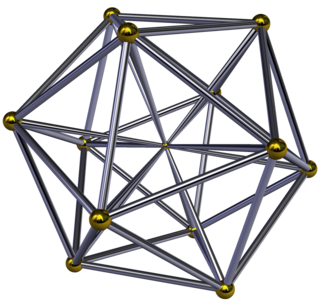Icosahedral pyramid
Appearance
| Icosahedral pyramid | ||
|---|---|---|
 Schlegel diagram | ||
| Type | Polyhedral pyramid | |
| Schläfli symbol | ( ) ∨ {3,5} | |
| Cells | 21 | 1 {3,5} 20 ( ) ∨ {3} |
| Faces | 50 | 20+30 {3} |
| Edges | 12+30 | |
| Vertices | 13 | |
| Dual | Dodecahedral pyramid | |
| Symmetry group | H3, [5,3,1], order 120 | |
| Properties | convex, regular-cells, Blind polytope | |
The icosahedral pyramid is a four-dimensional convex polytope, bounded by one icosahedron as its base and by 20 triangular pyramid cells which meet at its apex. Since an icosahedron's circumradius is less than its edge length,[1] the tetrahedral pyramids can be made with regular faces.
Having all regular cells, it is a Blind polytope. Two copies can be augmented to make an icosahedral bipyramid which is also a Blind Polytope.
The regular 600-cell has icosahedral pyramids around every vertex.
The dual to the icosahedral pyramid is the dodecahedral pyramid, seen as a dodecahedral base, and 12 regular pentagonal pyramids meeting at an apex.
Configuration
[edit]Seen in a configuration matrix, all incidence counts between elements are shown.[2]
| k-faces | fk | f0 | f1 | f2 | f3 | k-verfs | ||||
|---|---|---|---|---|---|---|---|---|---|---|
| ( ) | f0 | 1 | * | 12 | 0 | 30 | 0 | 20 | 0 | {3,5} |
| ( ) | * | 12 | 1 | 5 | 5 | 5 | 5 | 1 | {5}∨( ) | |
| ( )∨( ) | f1 | 1 | 1 | 12 | * | 5 | 0 | 5 | 0 | {5} |
| { } | 0 | 2 | * | 30 | 1 | 2 | 2 | 1 | { }∨( ) | |
| { }∨( ) | f2 | 1 | 2 | 2 | 1 | 30 | * | 2 | 0 | { } |
| {3} | 0 | 3 | 0 | 3 | * | 20 | 1 | 1 | ( )∨( ) | |
| {3}∨( ) | f3 | 1 | 3 | 3 | 3 | 3 | 1 | 20 | * | ( ) |
| {3,5} | 0 | 12 | 0 | 30 | 0 | 20 | * | 1 | ( ) | |
References
[edit]- ^ Klitzing, Richard. "3D convex uniform polyhedra x3o5o - ike"., circumradius sqrt[(5+sqrt(5))/8 = 0.951057
- ^ Klitzing, Richard. "ikepy".
External links
[edit]- Olshevsky, George. "Pyramid". Glossary for Hyperspace. Archived from the original on 4 February 2007.
- Klitzing, Richard. "4D Segmentotopes".
- Klitzing, Richard. "Segmentotope ikepy, K-4.84".
- Richard Klitzing, Axial-Symmetrical Edge Facetings of Uniform Polyhedra
- Icosahedral pyramid

